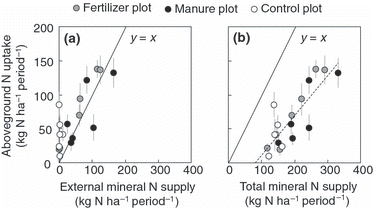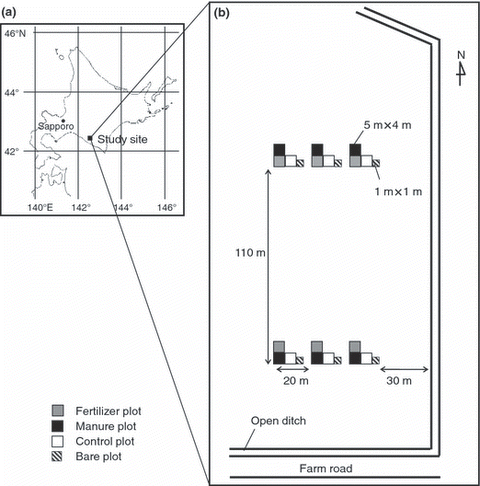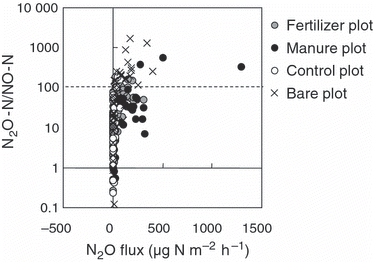Figures & data
Table 1 The botanical composition of grassland (dry matter weight percentage) on the study site
Table 2 The applied date and the application rates of chemical fertilizer and manure
Table 3 Mineralization rates from the cattle manure
Figure 2 Seasonal variations in meteorological variables and the N2O and NO flux; Daily precipitation and daily maximum snow depth (a), soil temperature at a 5-cm depth (b), water-filled pore space (WFPS) (c), N2O flux (d) and NO flux (e). Data of soil temperature, WFPS, N2O flux and NO flux represent means ± standard deviation (SD) (n = 6). The arrows indicate the timing of fertilizer or manure application.

Table 4 N deposition, gross N mineralization of soil (GMs), root-litter (GMl) and manure (GMm), and mineral N pool during each growing season (G1, G2 and G3) and non-growing season (NG) (kg N ha−1 period−1)
Table 5 N uptake in aboveground biomass during each growing season (G1, G2 and G3) and non-growing season (NG) (kg N ha−1 period−1)
Table 6 The cumulative N2O flux during each growing season (G1, G2 and G3) and non-growing season (NG) (kg N ha−1 period−1)
Figure 4 The cumulative N2O flux for each seasons (G1, G2, G3 and non-growing season [NG]) compared with the cumulative CO2 flux. G1 is the period from the beginning of the growing season to the first crop harvest, G2 is the period from the first harvest to the second harvest and G3 is the period from the second harvest to the end of the growing season. Data of the cumulative N2O flux represent means ± (uncertainties/100 × means). The cumulative CO2 flux was referred to Shimizu et al. (2009).
![Figure 4 The cumulative N2O flux for each seasons (G1, G2, G3 and non-growing season [NG]) compared with the cumulative CO2 flux. G1 is the period from the beginning of the growing season to the first crop harvest, G2 is the period from the first harvest to the second harvest and G3 is the period from the second harvest to the end of the growing season. Data of the cumulative N2O flux represent means ± (uncertainties/100 × means). The cumulative CO2 flux was referred to Shimizu et al. (2009).](/cms/asset/4d4e5770-1a37-4f88-9690-d92db9f68763/tssp_a_10382839_o_f0004g.gif)
Figure 5 N uptake in aboveground biomass during each growing season (G1, G2, G3) compared with the external mineral N supply (a) and total mineral N supply (b). The external N supply is composed of N deposition, chemical fertilizer application and the gross N mineralization of applied manure. The total mineral N supply is composed of the external N supply, gross N mineralization of soil and gross mineralization of root-litter. G1 is the period from the beginning of the growing season to the first crop harvest, G2 is the period from the first harvest to the second harvest and G3 is the period from the second harvest to the end of the growing season. The data of N uptake in aboveground biomass represent means ± (uncertainties/100 × means). The dashed-line indicates a regression model for all values, N uptake in aboveground biomass = 0.58 × total mineral N supply – 47; R2 = 0.68; P < 0.01.

Figure 6 The cumulative N2O flux for each season (G1, G2, G3 and non-growing season [NG]) compared with the total mineral N supply (a) and the mineral N surplus (b). The total mineral N supply is composed of the external N supply (N deposition, chemical fertilizer application and gross N mineralization of applied manure), gross N mineralization of soil and gross mineralization of root-litter. The mineral N surplus was estimated as the difference between the mineral N pool and N uptake in aboveground biomass. G1 is the period from the beginning of the growing season to the first crop harvest, G2 is the period from the first harvest to the second harvest and G3 is the period from the second harvest to the end of the growing season. The data of cumulative N2O flux represent means ± (uncertainties/100 × means). The regression model shown in Fig. 6a is for all values, Cumulative N2O flux = 0.0059 × (total mineral N supply) – 0.103; R2 = 0.37; P < 0.01. The regression model shown in Figure 6b is for all values, Cumulative N2O flux = 0.0120 × (mineral N surplus) – 0.537; R2 = 0.50; P < 0.01.
![Figure 6 The cumulative N2O flux for each season (G1, G2, G3 and non-growing season [NG]) compared with the total mineral N supply (a) and the mineral N surplus (b). The total mineral N supply is composed of the external N supply (N deposition, chemical fertilizer application and gross N mineralization of applied manure), gross N mineralization of soil and gross mineralization of root-litter. The mineral N surplus was estimated as the difference between the mineral N pool and N uptake in aboveground biomass. G1 is the period from the beginning of the growing season to the first crop harvest, G2 is the period from the first harvest to the second harvest and G3 is the period from the second harvest to the end of the growing season. The data of cumulative N2O flux represent means ± (uncertainties/100 × means). The regression model shown in Fig. 6a is for all values, Cumulative N2O flux = 0.0059 × (total mineral N supply) – 0.103; R2 = 0.37; P < 0.01. The regression model shown in Figure 6b is for all values, Cumulative N2O flux = 0.0120 × (mineral N surplus) – 0.537; R2 = 0.50; P < 0.01.](/cms/asset/d7e91a0c-f721-4f81-a89f-5d1bd3665f87/tssp_a_10382839_o_f0006g.gif)
Figure 7 The N2O emission factor to mineral N surplus for each season (G1, G2, G3 and non-growing season [NG]) compared with mean precipitation. The mineral N surplus was estimated as the difference between the mineral N pool and N uptake in aboveground biomass. G1 is the period from the beginning of the growing season to the first crop harvest, G2 is the period from the first harvest to the second harvest and G3 is the period from the second harvest to the end of the growing season. The data of N2O emission factor to mineral N surplus represent means ± (uncertainties/100 × means). The regression line is for all values, Cumulative N2O/mineral N surplus × 100 = 0.195 × mean precipitation – 0.055; R2 = 0.21; P < 0.01.
![Figure 7 The N2O emission factor to mineral N surplus for each season (G1, G2, G3 and non-growing season [NG]) compared with mean precipitation. The mineral N surplus was estimated as the difference between the mineral N pool and N uptake in aboveground biomass. G1 is the period from the beginning of the growing season to the first crop harvest, G2 is the period from the first harvest to the second harvest and G3 is the period from the second harvest to the end of the growing season. The data of N2O emission factor to mineral N surplus represent means ± (uncertainties/100 × means). The regression line is for all values, Cumulative N2O/mineral N surplus × 100 = 0.195 × mean precipitation – 0.055; R2 = 0.21; P < 0.01.](/cms/asset/4d8b3a9d-bf9f-4698-86a0-3d30116793c8/tssp_a_10382839_o_f0007g.gif)

